Business Law: Contractual Agreements, Liability, and Remedies
VerifiedAdded on 2022/10/01
|11
|3501
|12
Homework Assignment
AI Summary
This business law assignment analyzes two scenarios involving contract law principles. The first scenario focuses on a contract between Flyways Airlines and Boeing Corporation, examining contract formation, the validity of an exclusion clause, and the consequences of a breach of warranty regarding the entertainment system. The analysis considers offer, acceptance, and the enforceability of terms, including the impact of an exclusion clause not brought to the other party's attention before the contract. The second scenario involves multiple parties and contractual agreements, evaluating potential claims among them. It examines the formation of contracts, breach of contract, and the liabilities of each party involved. The assignment applies relevant legal principles and case law to determine the legal standing and potential claims in each scenario. It emphasizes the importance of valid contract formation, the impact of exclusion clauses, and the remedies available for breach of contract, such as damages.
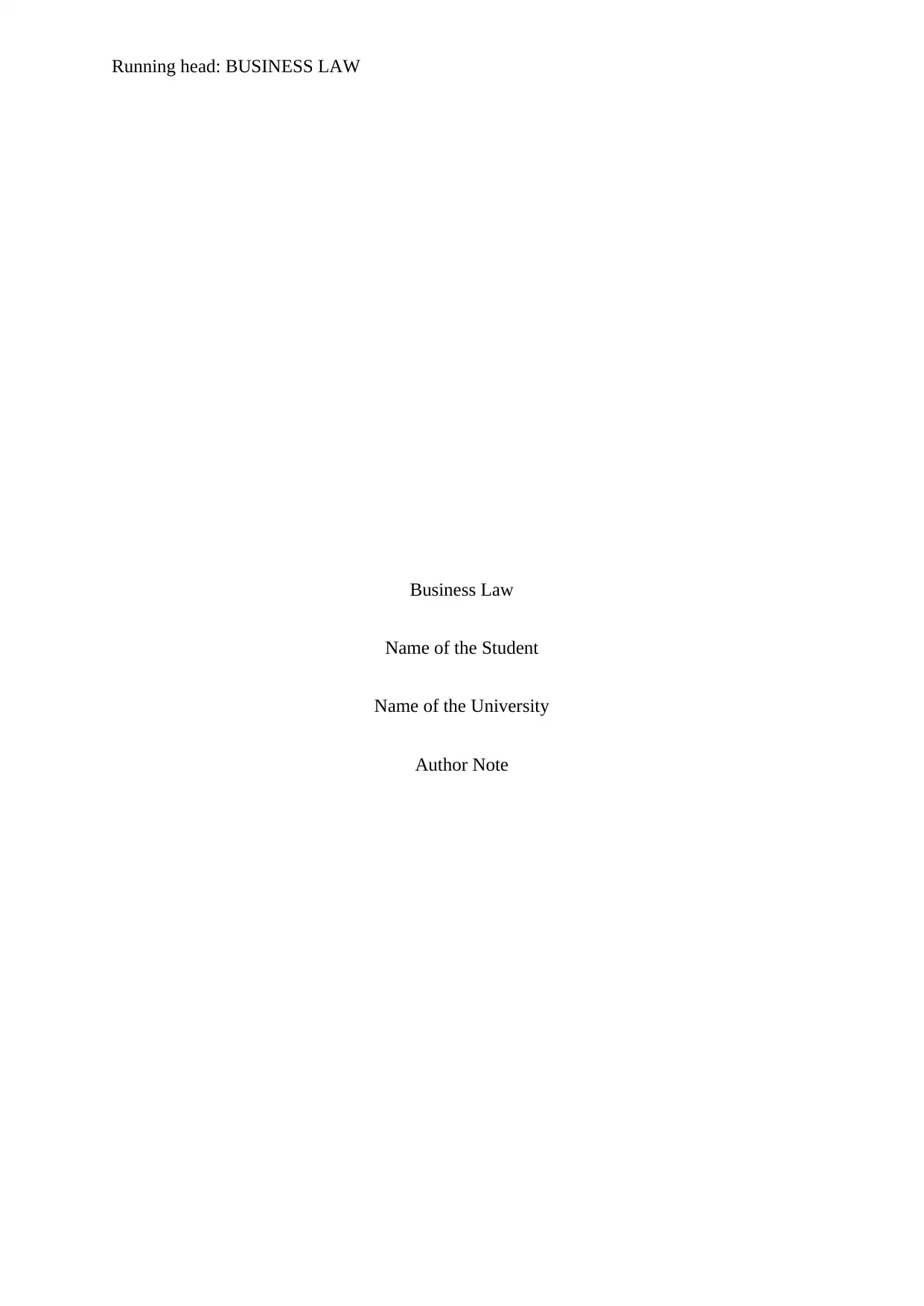
Running head: BUSINESS LAW
Business Law
Name of the Student
Name of the University
Author Note
Business Law
Name of the Student
Name of the University
Author Note
Paraphrase This Document
Need a fresh take? Get an instant paraphrase of this document with our AI Paraphraser
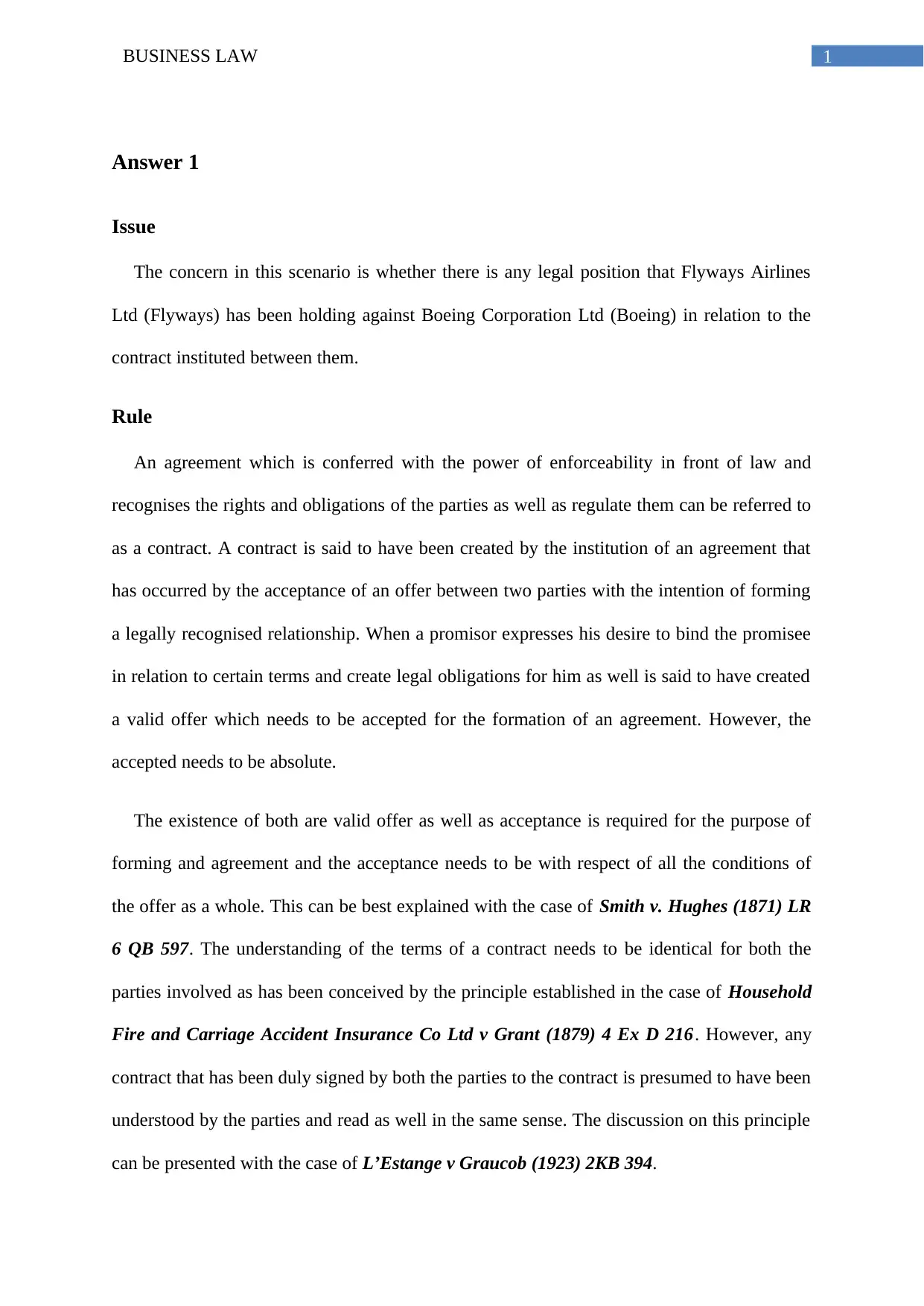
1BUSINESS LAW
Answer 1
Issue
The concern in this scenario is whether there is any legal position that Flyways Airlines
Ltd (Flyways) has been holding against Boeing Corporation Ltd (Boeing) in relation to the
contract instituted between them.
Rule
An agreement which is conferred with the power of enforceability in front of law and
recognises the rights and obligations of the parties as well as regulate them can be referred to
as a contract. A contract is said to have been created by the institution of an agreement that
has occurred by the acceptance of an offer between two parties with the intention of forming
a legally recognised relationship. When a promisor expresses his desire to bind the promisee
in relation to certain terms and create legal obligations for him as well is said to have created
a valid offer which needs to be accepted for the formation of an agreement. However, the
accepted needs to be absolute.
The existence of both are valid offer as well as acceptance is required for the purpose of
forming and agreement and the acceptance needs to be with respect of all the conditions of
the offer as a whole. This can be best explained with the case of Smith v. Hughes (1871) LR
6 QB 597. The understanding of the terms of a contract needs to be identical for both the
parties involved as has been conceived by the principle established in the case of Household
Fire and Carriage Accident Insurance Co Ltd v Grant (1879) 4 Ex D 216. However, any
contract that has been duly signed by both the parties to the contract is presumed to have been
understood by the parties and read as well in the same sense. The discussion on this principle
can be presented with the case of L’Estange v Graucob (1923) 2KB 394.
Answer 1
Issue
The concern in this scenario is whether there is any legal position that Flyways Airlines
Ltd (Flyways) has been holding against Boeing Corporation Ltd (Boeing) in relation to the
contract instituted between them.
Rule
An agreement which is conferred with the power of enforceability in front of law and
recognises the rights and obligations of the parties as well as regulate them can be referred to
as a contract. A contract is said to have been created by the institution of an agreement that
has occurred by the acceptance of an offer between two parties with the intention of forming
a legally recognised relationship. When a promisor expresses his desire to bind the promisee
in relation to certain terms and create legal obligations for him as well is said to have created
a valid offer which needs to be accepted for the formation of an agreement. However, the
accepted needs to be absolute.
The existence of both are valid offer as well as acceptance is required for the purpose of
forming and agreement and the acceptance needs to be with respect of all the conditions of
the offer as a whole. This can be best explained with the case of Smith v. Hughes (1871) LR
6 QB 597. The understanding of the terms of a contract needs to be identical for both the
parties involved as has been conceived by the principle established in the case of Household
Fire and Carriage Accident Insurance Co Ltd v Grant (1879) 4 Ex D 216. However, any
contract that has been duly signed by both the parties to the contract is presumed to have been
understood by the parties and read as well in the same sense. The discussion on this principle
can be presented with the case of L’Estange v Graucob (1923) 2KB 394.
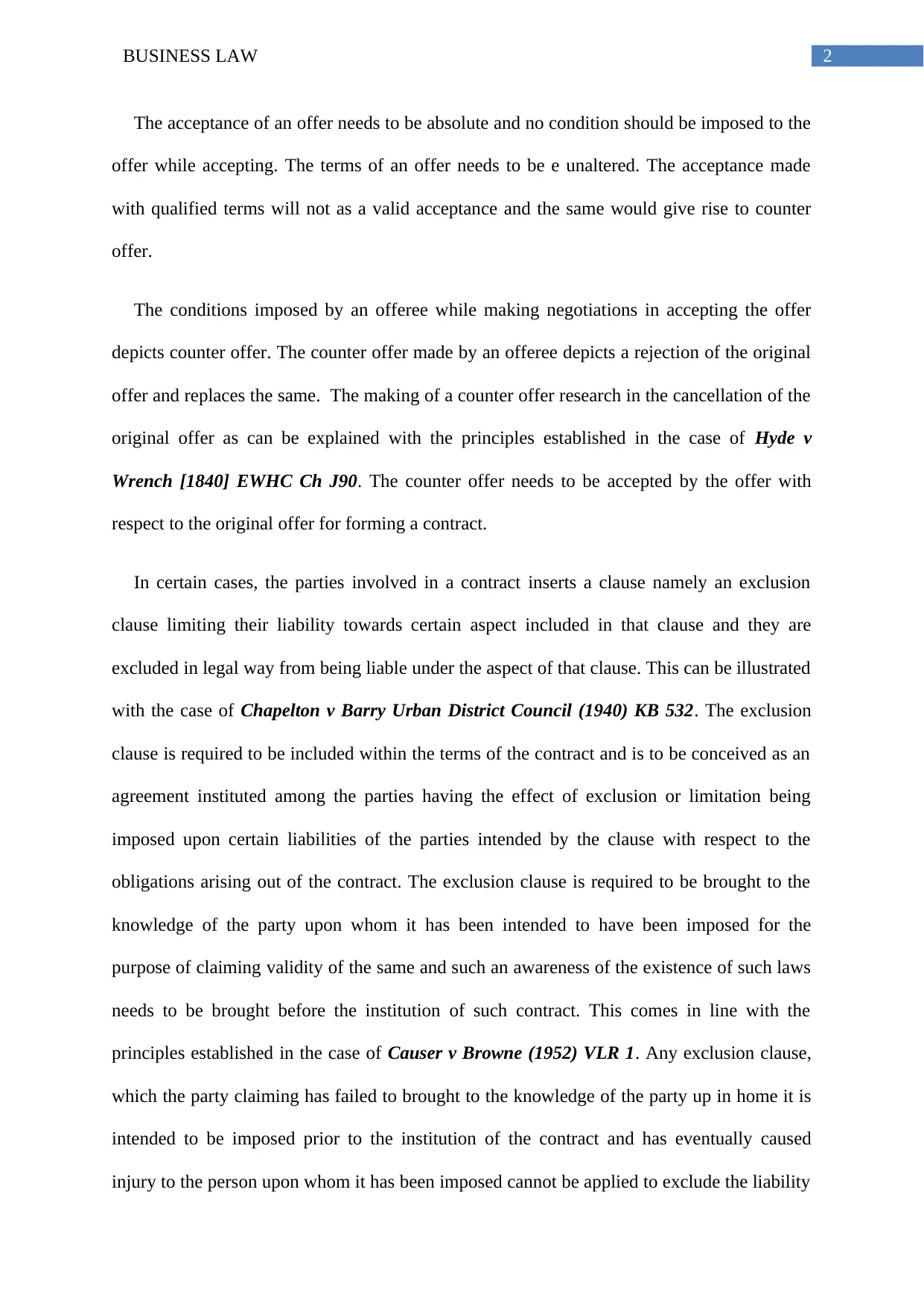
2BUSINESS LAW
The acceptance of an offer needs to be absolute and no condition should be imposed to the
offer while accepting. The terms of an offer needs to be e unaltered. The acceptance made
with qualified terms will not as a valid acceptance and the same would give rise to counter
offer.
The conditions imposed by an offeree while making negotiations in accepting the offer
depicts counter offer. The counter offer made by an offeree depicts a rejection of the original
offer and replaces the same. The making of a counter offer research in the cancellation of the
original offer as can be explained with the principles established in the case of Hyde v
Wrench [1840] EWHC Ch J90. The counter offer needs to be accepted by the offer with
respect to the original offer for forming a contract.
In certain cases, the parties involved in a contract inserts a clause namely an exclusion
clause limiting their liability towards certain aspect included in that clause and they are
excluded in legal way from being liable under the aspect of that clause. This can be illustrated
with the case of Chapelton v Barry Urban District Council (1940) KB 532. The exclusion
clause is required to be included within the terms of the contract and is to be conceived as an
agreement instituted among the parties having the effect of exclusion or limitation being
imposed upon certain liabilities of the parties intended by the clause with respect to the
obligations arising out of the contract. The exclusion clause is required to be brought to the
knowledge of the party upon whom it has been intended to have been imposed for the
purpose of claiming validity of the same and such an awareness of the existence of such laws
needs to be brought before the institution of such contract. This comes in line with the
principles established in the case of Causer v Browne (1952) VLR 1. Any exclusion clause,
which the party claiming has failed to brought to the knowledge of the party up in home it is
intended to be imposed prior to the institution of the contract and has eventually caused
injury to the person upon whom it has been imposed cannot be applied to exclude the liability
The acceptance of an offer needs to be absolute and no condition should be imposed to the
offer while accepting. The terms of an offer needs to be e unaltered. The acceptance made
with qualified terms will not as a valid acceptance and the same would give rise to counter
offer.
The conditions imposed by an offeree while making negotiations in accepting the offer
depicts counter offer. The counter offer made by an offeree depicts a rejection of the original
offer and replaces the same. The making of a counter offer research in the cancellation of the
original offer as can be explained with the principles established in the case of Hyde v
Wrench [1840] EWHC Ch J90. The counter offer needs to be accepted by the offer with
respect to the original offer for forming a contract.
In certain cases, the parties involved in a contract inserts a clause namely an exclusion
clause limiting their liability towards certain aspect included in that clause and they are
excluded in legal way from being liable under the aspect of that clause. This can be illustrated
with the case of Chapelton v Barry Urban District Council (1940) KB 532. The exclusion
clause is required to be included within the terms of the contract and is to be conceived as an
agreement instituted among the parties having the effect of exclusion or limitation being
imposed upon certain liabilities of the parties intended by the clause with respect to the
obligations arising out of the contract. The exclusion clause is required to be brought to the
knowledge of the party upon whom it has been intended to have been imposed for the
purpose of claiming validity of the same and such an awareness of the existence of such laws
needs to be brought before the institution of such contract. This comes in line with the
principles established in the case of Causer v Browne (1952) VLR 1. Any exclusion clause,
which the party claiming has failed to brought to the knowledge of the party up in home it is
intended to be imposed prior to the institution of the contract and has eventually caused
injury to the person upon whom it has been imposed cannot be applied to exclude the liability
⊘ This is a preview!⊘
Do you want full access?
Subscribe today to unlock all pages.

Trusted by 1+ million students worldwide
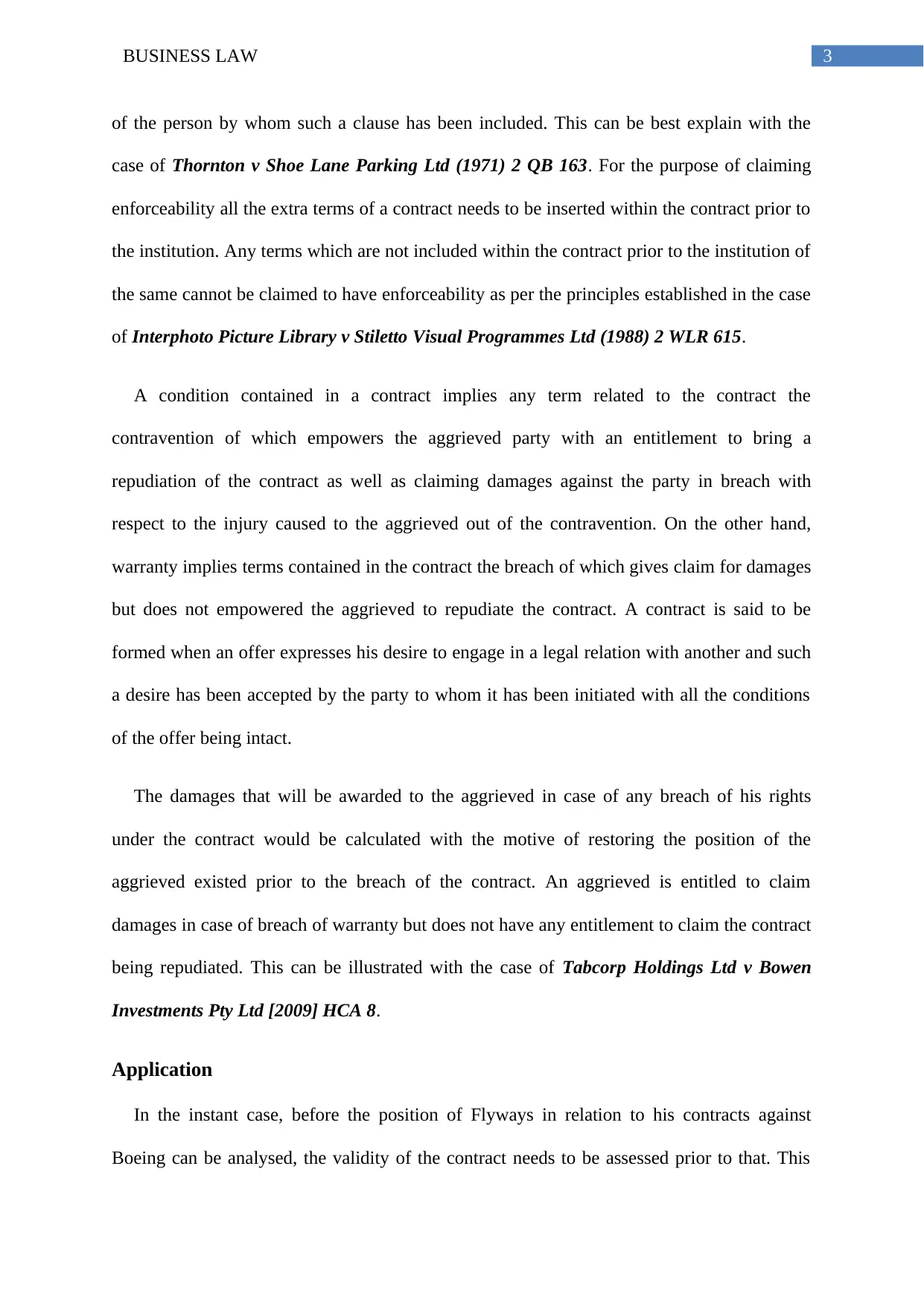
3BUSINESS LAW
of the person by whom such a clause has been included. This can be best explain with the
case of Thornton v Shoe Lane Parking Ltd (1971) 2 QB 163. For the purpose of claiming
enforceability all the extra terms of a contract needs to be inserted within the contract prior to
the institution. Any terms which are not included within the contract prior to the institution of
the same cannot be claimed to have enforceability as per the principles established in the case
of Interphoto Picture Library v Stiletto Visual Programmes Ltd (1988) 2 WLR 615.
A condition contained in a contract implies any term related to the contract the
contravention of which empowers the aggrieved party with an entitlement to bring a
repudiation of the contract as well as claiming damages against the party in breach with
respect to the injury caused to the aggrieved out of the contravention. On the other hand,
warranty implies terms contained in the contract the breach of which gives claim for damages
but does not empowered the aggrieved to repudiate the contract. A contract is said to be
formed when an offer expresses his desire to engage in a legal relation with another and such
a desire has been accepted by the party to whom it has been initiated with all the conditions
of the offer being intact.
The damages that will be awarded to the aggrieved in case of any breach of his rights
under the contract would be calculated with the motive of restoring the position of the
aggrieved existed prior to the breach of the contract. An aggrieved is entitled to claim
damages in case of breach of warranty but does not have any entitlement to claim the contract
being repudiated. This can be illustrated with the case of Tabcorp Holdings Ltd v Bowen
Investments Pty Ltd [2009] HCA 8.
Application
In the instant case, before the position of Flyways in relation to his contracts against
Boeing can be analysed, the validity of the contract needs to be assessed prior to that. This
of the person by whom such a clause has been included. This can be best explain with the
case of Thornton v Shoe Lane Parking Ltd (1971) 2 QB 163. For the purpose of claiming
enforceability all the extra terms of a contract needs to be inserted within the contract prior to
the institution. Any terms which are not included within the contract prior to the institution of
the same cannot be claimed to have enforceability as per the principles established in the case
of Interphoto Picture Library v Stiletto Visual Programmes Ltd (1988) 2 WLR 615.
A condition contained in a contract implies any term related to the contract the
contravention of which empowers the aggrieved party with an entitlement to bring a
repudiation of the contract as well as claiming damages against the party in breach with
respect to the injury caused to the aggrieved out of the contravention. On the other hand,
warranty implies terms contained in the contract the breach of which gives claim for damages
but does not empowered the aggrieved to repudiate the contract. A contract is said to be
formed when an offer expresses his desire to engage in a legal relation with another and such
a desire has been accepted by the party to whom it has been initiated with all the conditions
of the offer being intact.
The damages that will be awarded to the aggrieved in case of any breach of his rights
under the contract would be calculated with the motive of restoring the position of the
aggrieved existed prior to the breach of the contract. An aggrieved is entitled to claim
damages in case of breach of warranty but does not have any entitlement to claim the contract
being repudiated. This can be illustrated with the case of Tabcorp Holdings Ltd v Bowen
Investments Pty Ltd [2009] HCA 8.
Application
In the instant case, before the position of Flyways in relation to his contracts against
Boeing can be analysed, the validity of the contract needs to be assessed prior to that. This
Paraphrase This Document
Need a fresh take? Get an instant paraphrase of this document with our AI Paraphraser
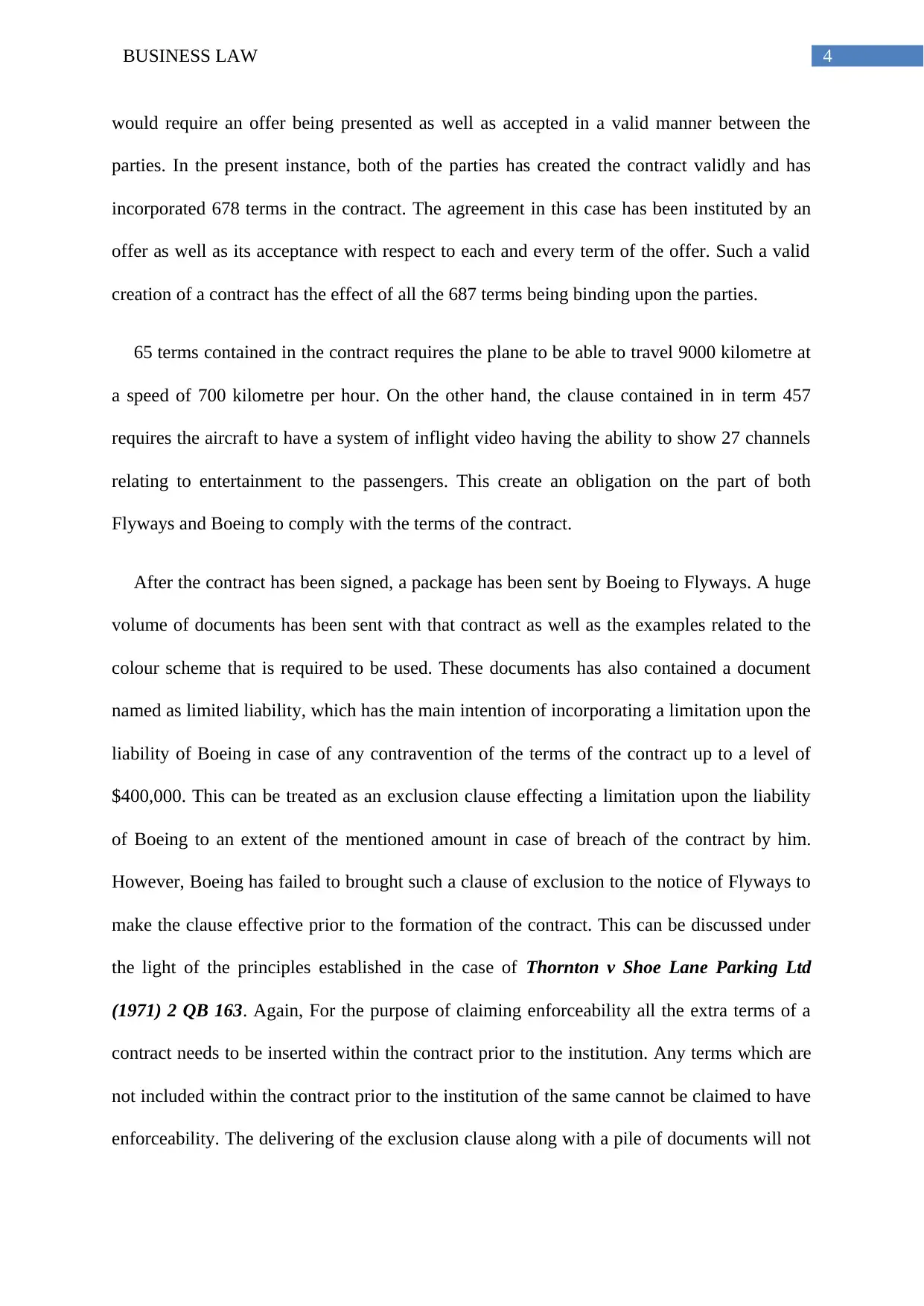
4BUSINESS LAW
would require an offer being presented as well as accepted in a valid manner between the
parties. In the present instance, both of the parties has created the contract validly and has
incorporated 678 terms in the contract. The agreement in this case has been instituted by an
offer as well as its acceptance with respect to each and every term of the offer. Such a valid
creation of a contract has the effect of all the 687 terms being binding upon the parties.
65 terms contained in the contract requires the plane to be able to travel 9000 kilometre at
a speed of 700 kilometre per hour. On the other hand, the clause contained in in term 457
requires the aircraft to have a system of inflight video having the ability to show 27 channels
relating to entertainment to the passengers. This create an obligation on the part of both
Flyways and Boeing to comply with the terms of the contract.
After the contract has been signed, a package has been sent by Boeing to Flyways. A huge
volume of documents has been sent with that contract as well as the examples related to the
colour scheme that is required to be used. These documents has also contained a document
named as limited liability, which has the main intention of incorporating a limitation upon the
liability of Boeing in case of any contravention of the terms of the contract up to a level of
$400,000. This can be treated as an exclusion clause effecting a limitation upon the liability
of Boeing to an extent of the mentioned amount in case of breach of the contract by him.
However, Boeing has failed to brought such a clause of exclusion to the notice of Flyways to
make the clause effective prior to the formation of the contract. This can be discussed under
the light of the principles established in the case of Thornton v Shoe Lane Parking Ltd
(1971) 2 QB 163. Again, For the purpose of claiming enforceability all the extra terms of a
contract needs to be inserted within the contract prior to the institution. Any terms which are
not included within the contract prior to the institution of the same cannot be claimed to have
enforceability. The delivering of the exclusion clause along with a pile of documents will not
would require an offer being presented as well as accepted in a valid manner between the
parties. In the present instance, both of the parties has created the contract validly and has
incorporated 678 terms in the contract. The agreement in this case has been instituted by an
offer as well as its acceptance with respect to each and every term of the offer. Such a valid
creation of a contract has the effect of all the 687 terms being binding upon the parties.
65 terms contained in the contract requires the plane to be able to travel 9000 kilometre at
a speed of 700 kilometre per hour. On the other hand, the clause contained in in term 457
requires the aircraft to have a system of inflight video having the ability to show 27 channels
relating to entertainment to the passengers. This create an obligation on the part of both
Flyways and Boeing to comply with the terms of the contract.
After the contract has been signed, a package has been sent by Boeing to Flyways. A huge
volume of documents has been sent with that contract as well as the examples related to the
colour scheme that is required to be used. These documents has also contained a document
named as limited liability, which has the main intention of incorporating a limitation upon the
liability of Boeing in case of any contravention of the terms of the contract up to a level of
$400,000. This can be treated as an exclusion clause effecting a limitation upon the liability
of Boeing to an extent of the mentioned amount in case of breach of the contract by him.
However, Boeing has failed to brought such a clause of exclusion to the notice of Flyways to
make the clause effective prior to the formation of the contract. This can be discussed under
the light of the principles established in the case of Thornton v Shoe Lane Parking Ltd
(1971) 2 QB 163. Again, For the purpose of claiming enforceability all the extra terms of a
contract needs to be inserted within the contract prior to the institution. Any terms which are
not included within the contract prior to the institution of the same cannot be claimed to have
enforceability. The delivering of the exclusion clause along with a pile of documents will not
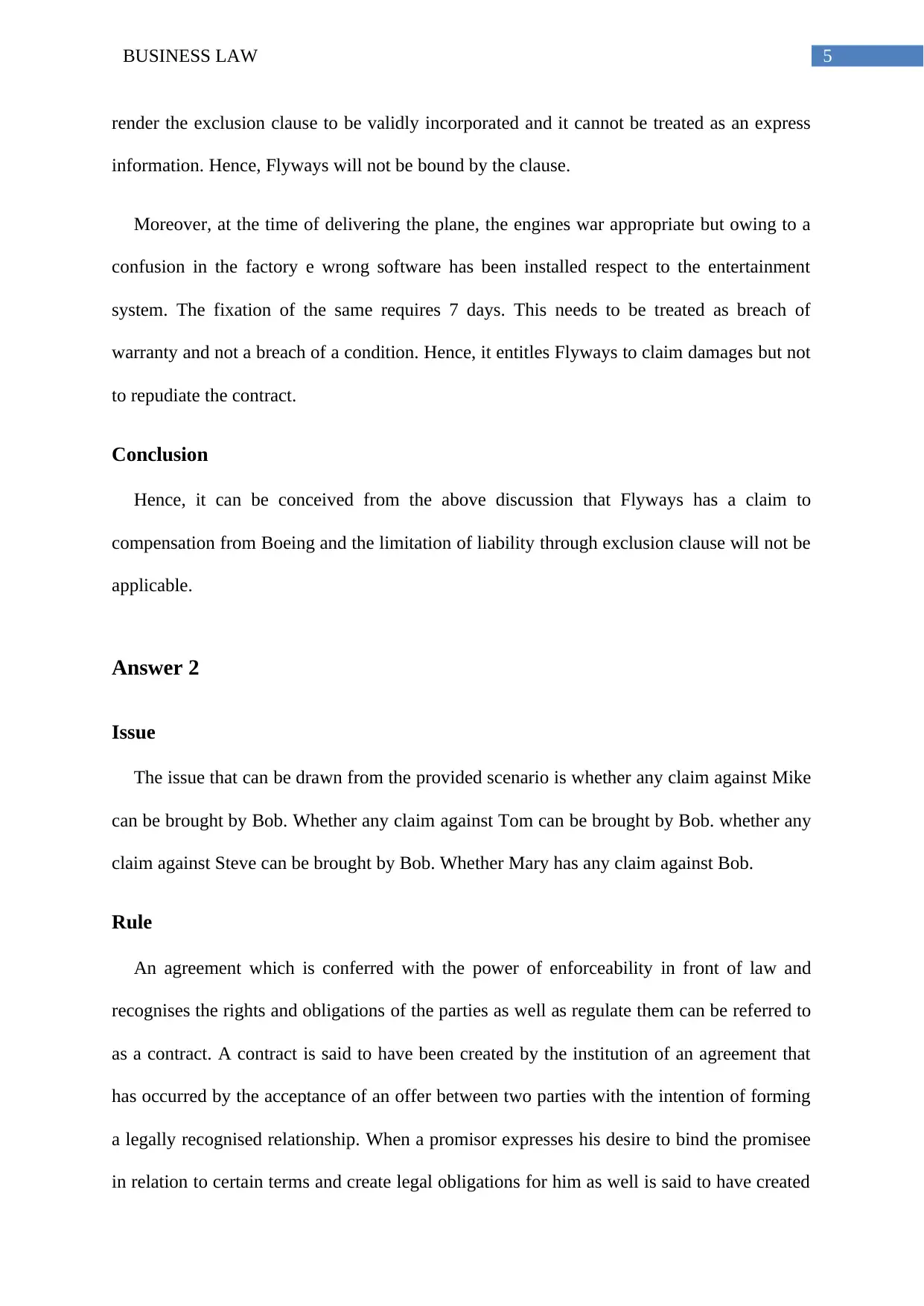
5BUSINESS LAW
render the exclusion clause to be validly incorporated and it cannot be treated as an express
information. Hence, Flyways will not be bound by the clause.
Moreover, at the time of delivering the plane, the engines war appropriate but owing to a
confusion in the factory e wrong software has been installed respect to the entertainment
system. The fixation of the same requires 7 days. This needs to be treated as breach of
warranty and not a breach of a condition. Hence, it entitles Flyways to claim damages but not
to repudiate the contract.
Conclusion
Hence, it can be conceived from the above discussion that Flyways has a claim to
compensation from Boeing and the limitation of liability through exclusion clause will not be
applicable.
Answer 2
Issue
The issue that can be drawn from the provided scenario is whether any claim against Mike
can be brought by Bob. Whether any claim against Tom can be brought by Bob. whether any
claim against Steve can be brought by Bob. Whether Mary has any claim against Bob.
Rule
An agreement which is conferred with the power of enforceability in front of law and
recognises the rights and obligations of the parties as well as regulate them can be referred to
as a contract. A contract is said to have been created by the institution of an agreement that
has occurred by the acceptance of an offer between two parties with the intention of forming
a legally recognised relationship. When a promisor expresses his desire to bind the promisee
in relation to certain terms and create legal obligations for him as well is said to have created
render the exclusion clause to be validly incorporated and it cannot be treated as an express
information. Hence, Flyways will not be bound by the clause.
Moreover, at the time of delivering the plane, the engines war appropriate but owing to a
confusion in the factory e wrong software has been installed respect to the entertainment
system. The fixation of the same requires 7 days. This needs to be treated as breach of
warranty and not a breach of a condition. Hence, it entitles Flyways to claim damages but not
to repudiate the contract.
Conclusion
Hence, it can be conceived from the above discussion that Flyways has a claim to
compensation from Boeing and the limitation of liability through exclusion clause will not be
applicable.
Answer 2
Issue
The issue that can be drawn from the provided scenario is whether any claim against Mike
can be brought by Bob. Whether any claim against Tom can be brought by Bob. whether any
claim against Steve can be brought by Bob. Whether Mary has any claim against Bob.
Rule
An agreement which is conferred with the power of enforceability in front of law and
recognises the rights and obligations of the parties as well as regulate them can be referred to
as a contract. A contract is said to have been created by the institution of an agreement that
has occurred by the acceptance of an offer between two parties with the intention of forming
a legally recognised relationship. When a promisor expresses his desire to bind the promisee
in relation to certain terms and create legal obligations for him as well is said to have created
⊘ This is a preview!⊘
Do you want full access?
Subscribe today to unlock all pages.

Trusted by 1+ million students worldwide
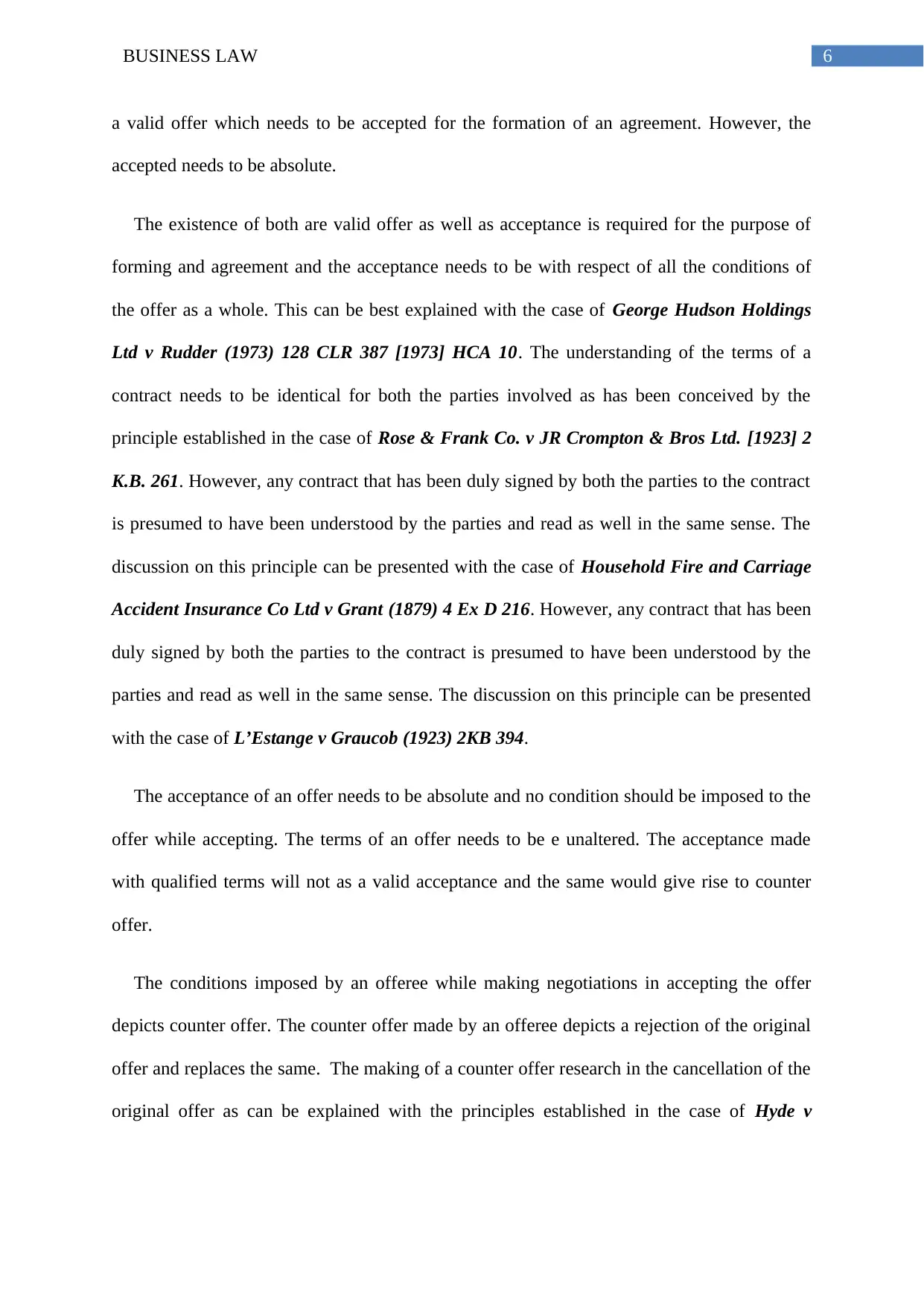
6BUSINESS LAW
a valid offer which needs to be accepted for the formation of an agreement. However, the
accepted needs to be absolute.
The existence of both are valid offer as well as acceptance is required for the purpose of
forming and agreement and the acceptance needs to be with respect of all the conditions of
the offer as a whole. This can be best explained with the case of George Hudson Holdings
Ltd v Rudder (1973) 128 CLR 387 [1973] HCA 10. The understanding of the terms of a
contract needs to be identical for both the parties involved as has been conceived by the
principle established in the case of Rose & Frank Co. v JR Crompton & Bros Ltd. [1923] 2
K.B. 261. However, any contract that has been duly signed by both the parties to the contract
is presumed to have been understood by the parties and read as well in the same sense. The
discussion on this principle can be presented with the case of Household Fire and Carriage
Accident Insurance Co Ltd v Grant (1879) 4 Ex D 216. However, any contract that has been
duly signed by both the parties to the contract is presumed to have been understood by the
parties and read as well in the same sense. The discussion on this principle can be presented
with the case of L’Estange v Graucob (1923) 2KB 394.
The acceptance of an offer needs to be absolute and no condition should be imposed to the
offer while accepting. The terms of an offer needs to be e unaltered. The acceptance made
with qualified terms will not as a valid acceptance and the same would give rise to counter
offer.
The conditions imposed by an offeree while making negotiations in accepting the offer
depicts counter offer. The counter offer made by an offeree depicts a rejection of the original
offer and replaces the same. The making of a counter offer research in the cancellation of the
original offer as can be explained with the principles established in the case of Hyde v
a valid offer which needs to be accepted for the formation of an agreement. However, the
accepted needs to be absolute.
The existence of both are valid offer as well as acceptance is required for the purpose of
forming and agreement and the acceptance needs to be with respect of all the conditions of
the offer as a whole. This can be best explained with the case of George Hudson Holdings
Ltd v Rudder (1973) 128 CLR 387 [1973] HCA 10. The understanding of the terms of a
contract needs to be identical for both the parties involved as has been conceived by the
principle established in the case of Rose & Frank Co. v JR Crompton & Bros Ltd. [1923] 2
K.B. 261. However, any contract that has been duly signed by both the parties to the contract
is presumed to have been understood by the parties and read as well in the same sense. The
discussion on this principle can be presented with the case of Household Fire and Carriage
Accident Insurance Co Ltd v Grant (1879) 4 Ex D 216. However, any contract that has been
duly signed by both the parties to the contract is presumed to have been understood by the
parties and read as well in the same sense. The discussion on this principle can be presented
with the case of L’Estange v Graucob (1923) 2KB 394.
The acceptance of an offer needs to be absolute and no condition should be imposed to the
offer while accepting. The terms of an offer needs to be e unaltered. The acceptance made
with qualified terms will not as a valid acceptance and the same would give rise to counter
offer.
The conditions imposed by an offeree while making negotiations in accepting the offer
depicts counter offer. The counter offer made by an offeree depicts a rejection of the original
offer and replaces the same. The making of a counter offer research in the cancellation of the
original offer as can be explained with the principles established in the case of Hyde v
Paraphrase This Document
Need a fresh take? Get an instant paraphrase of this document with our AI Paraphraser
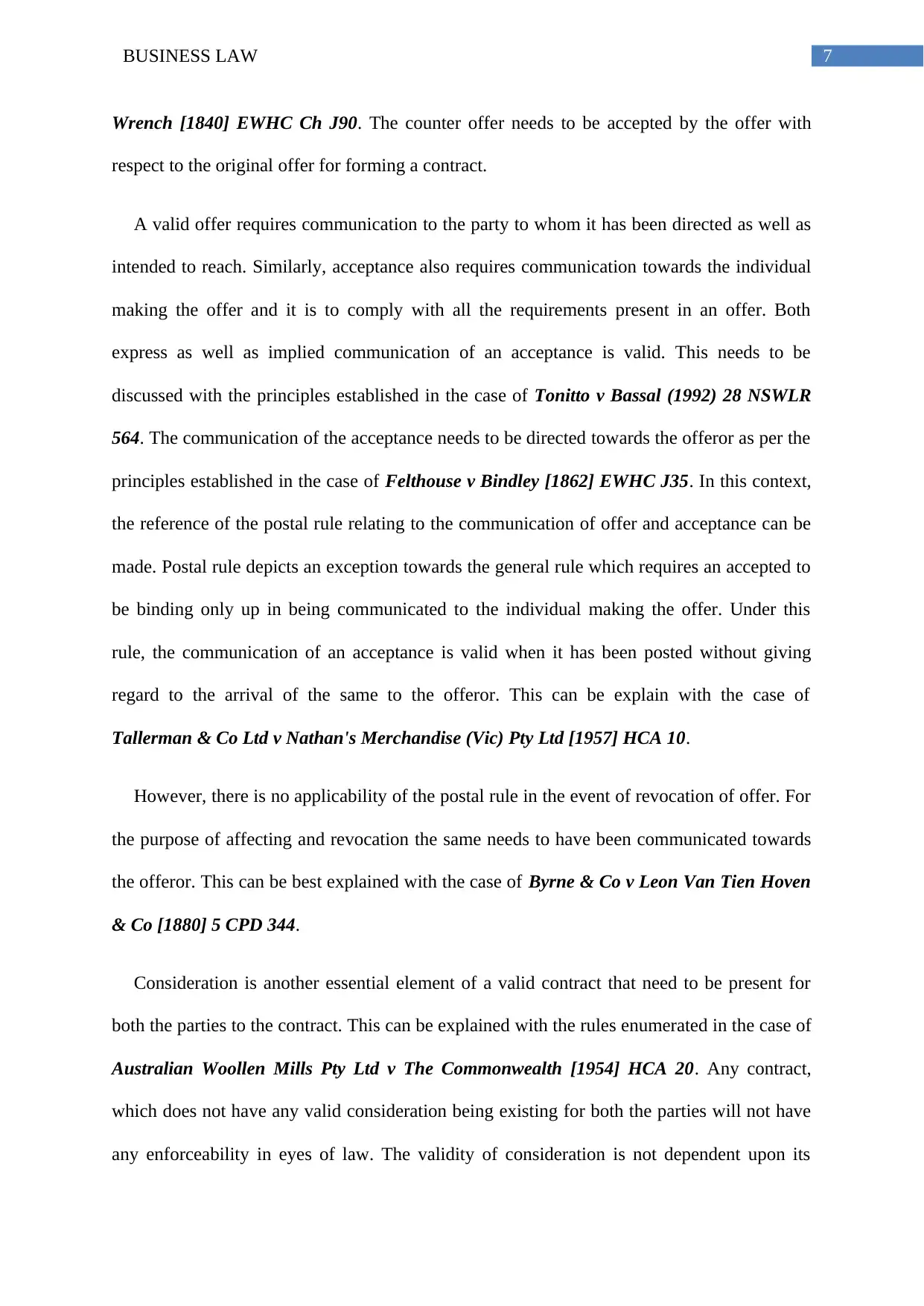
7BUSINESS LAW
Wrench [1840] EWHC Ch J90. The counter offer needs to be accepted by the offer with
respect to the original offer for forming a contract.
A valid offer requires communication to the party to whom it has been directed as well as
intended to reach. Similarly, acceptance also requires communication towards the individual
making the offer and it is to comply with all the requirements present in an offer. Both
express as well as implied communication of an acceptance is valid. This needs to be
discussed with the principles established in the case of Tonitto v Bassal (1992) 28 NSWLR
564. The communication of the acceptance needs to be directed towards the offeror as per the
principles established in the case of Felthouse v Bindley [1862] EWHC J35. In this context,
the reference of the postal rule relating to the communication of offer and acceptance can be
made. Postal rule depicts an exception towards the general rule which requires an accepted to
be binding only up in being communicated to the individual making the offer. Under this
rule, the communication of an acceptance is valid when it has been posted without giving
regard to the arrival of the same to the offeror. This can be explain with the case of
Tallerman & Co Ltd v Nathan's Merchandise (Vic) Pty Ltd [1957] HCA 10.
However, there is no applicability of the postal rule in the event of revocation of offer. For
the purpose of affecting and revocation the same needs to have been communicated towards
the offeror. This can be best explained with the case of Byrne & Co v Leon Van Tien Hoven
& Co [1880] 5 CPD 344.
Consideration is another essential element of a valid contract that need to be present for
both the parties to the contract. This can be explained with the rules enumerated in the case of
Australian Woollen Mills Pty Ltd v The Commonwealth [1954] HCA 20. Any contract,
which does not have any valid consideration being existing for both the parties will not have
any enforceability in eyes of law. The validity of consideration is not dependent upon its
Wrench [1840] EWHC Ch J90. The counter offer needs to be accepted by the offer with
respect to the original offer for forming a contract.
A valid offer requires communication to the party to whom it has been directed as well as
intended to reach. Similarly, acceptance also requires communication towards the individual
making the offer and it is to comply with all the requirements present in an offer. Both
express as well as implied communication of an acceptance is valid. This needs to be
discussed with the principles established in the case of Tonitto v Bassal (1992) 28 NSWLR
564. The communication of the acceptance needs to be directed towards the offeror as per the
principles established in the case of Felthouse v Bindley [1862] EWHC J35. In this context,
the reference of the postal rule relating to the communication of offer and acceptance can be
made. Postal rule depicts an exception towards the general rule which requires an accepted to
be binding only up in being communicated to the individual making the offer. Under this
rule, the communication of an acceptance is valid when it has been posted without giving
regard to the arrival of the same to the offeror. This can be explain with the case of
Tallerman & Co Ltd v Nathan's Merchandise (Vic) Pty Ltd [1957] HCA 10.
However, there is no applicability of the postal rule in the event of revocation of offer. For
the purpose of affecting and revocation the same needs to have been communicated towards
the offeror. This can be best explained with the case of Byrne & Co v Leon Van Tien Hoven
& Co [1880] 5 CPD 344.
Consideration is another essential element of a valid contract that need to be present for
both the parties to the contract. This can be explained with the rules enumerated in the case of
Australian Woollen Mills Pty Ltd v The Commonwealth [1954] HCA 20. Any contract,
which does not have any valid consideration being existing for both the parties will not have
any enforceability in eyes of law. The validity of consideration is not dependent upon its
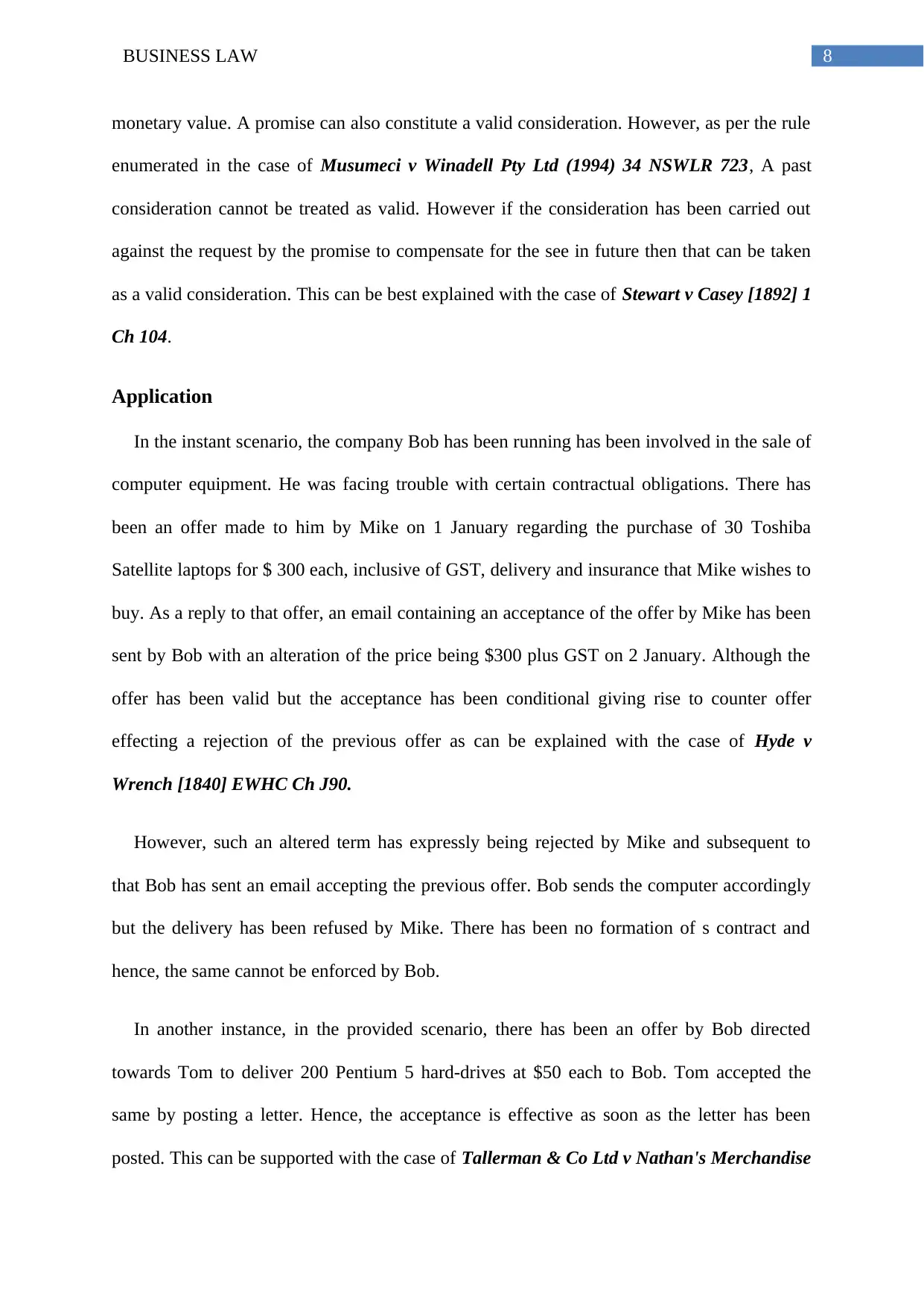
8BUSINESS LAW
monetary value. A promise can also constitute a valid consideration. However, as per the rule
enumerated in the case of Musumeci v Winadell Pty Ltd (1994) 34 NSWLR 723, A past
consideration cannot be treated as valid. However if the consideration has been carried out
against the request by the promise to compensate for the see in future then that can be taken
as a valid consideration. This can be best explained with the case of Stewart v Casey [1892] 1
Ch 104.
Application
In the instant scenario, the company Bob has been running has been involved in the sale of
computer equipment. He was facing trouble with certain contractual obligations. There has
been an offer made to him by Mike on 1 January regarding the purchase of 30 Toshiba
Satellite laptops for $ 300 each, inclusive of GST, delivery and insurance that Mike wishes to
buy. As a reply to that offer, an email containing an acceptance of the offer by Mike has been
sent by Bob with an alteration of the price being $300 plus GST on 2 January. Although the
offer has been valid but the acceptance has been conditional giving rise to counter offer
effecting a rejection of the previous offer as can be explained with the case of Hyde v
Wrench [1840] EWHC Ch J90.
However, such an altered term has expressly being rejected by Mike and subsequent to
that Bob has sent an email accepting the previous offer. Bob sends the computer accordingly
but the delivery has been refused by Mike. There has been no formation of s contract and
hence, the same cannot be enforced by Bob.
In another instance, in the provided scenario, there has been an offer by Bob directed
towards Tom to deliver 200 Pentium 5 hard-drives at $50 each to Bob. Tom accepted the
same by posting a letter. Hence, the acceptance is effective as soon as the letter has been
posted. This can be supported with the case of Tallerman & Co Ltd v Nathan's Merchandise
monetary value. A promise can also constitute a valid consideration. However, as per the rule
enumerated in the case of Musumeci v Winadell Pty Ltd (1994) 34 NSWLR 723, A past
consideration cannot be treated as valid. However if the consideration has been carried out
against the request by the promise to compensate for the see in future then that can be taken
as a valid consideration. This can be best explained with the case of Stewart v Casey [1892] 1
Ch 104.
Application
In the instant scenario, the company Bob has been running has been involved in the sale of
computer equipment. He was facing trouble with certain contractual obligations. There has
been an offer made to him by Mike on 1 January regarding the purchase of 30 Toshiba
Satellite laptops for $ 300 each, inclusive of GST, delivery and insurance that Mike wishes to
buy. As a reply to that offer, an email containing an acceptance of the offer by Mike has been
sent by Bob with an alteration of the price being $300 plus GST on 2 January. Although the
offer has been valid but the acceptance has been conditional giving rise to counter offer
effecting a rejection of the previous offer as can be explained with the case of Hyde v
Wrench [1840] EWHC Ch J90.
However, such an altered term has expressly being rejected by Mike and subsequent to
that Bob has sent an email accepting the previous offer. Bob sends the computer accordingly
but the delivery has been refused by Mike. There has been no formation of s contract and
hence, the same cannot be enforced by Bob.
In another instance, in the provided scenario, there has been an offer by Bob directed
towards Tom to deliver 200 Pentium 5 hard-drives at $50 each to Bob. Tom accepted the
same by posting a letter. Hence, the acceptance is effective as soon as the letter has been
posted. This can be supported with the case of Tallerman & Co Ltd v Nathan's Merchandise
⊘ This is a preview!⊘
Do you want full access?
Subscribe today to unlock all pages.

Trusted by 1+ million students worldwide
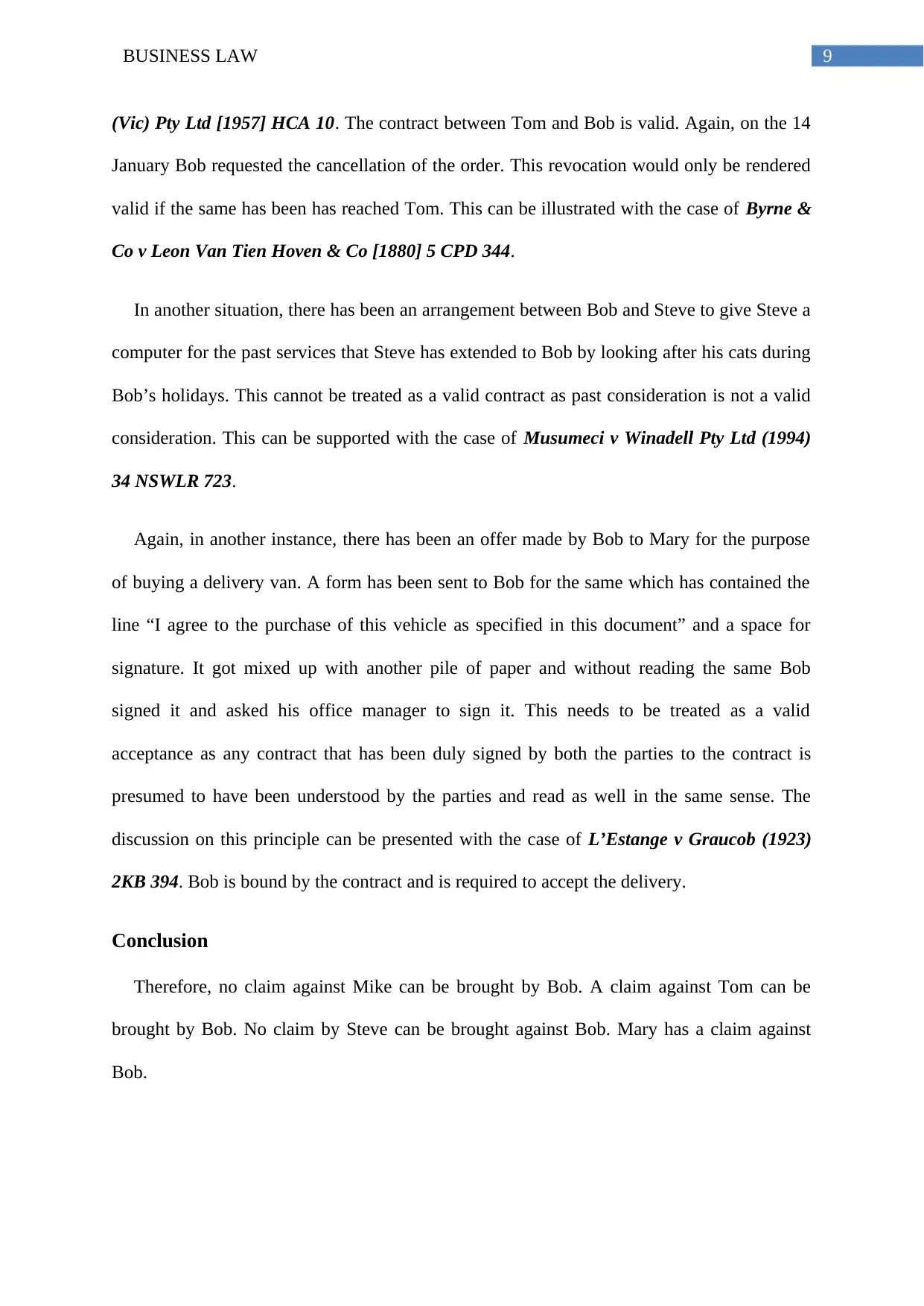
9BUSINESS LAW
(Vic) Pty Ltd [1957] HCA 10. The contract between Tom and Bob is valid. Again, on the 14
January Bob requested the cancellation of the order. This revocation would only be rendered
valid if the same has been has reached Tom. This can be illustrated with the case of Byrne &
Co v Leon Van Tien Hoven & Co [1880] 5 CPD 344.
In another situation, there has been an arrangement between Bob and Steve to give Steve a
computer for the past services that Steve has extended to Bob by looking after his cats during
Bob’s holidays. This cannot be treated as a valid contract as past consideration is not a valid
consideration. This can be supported with the case of Musumeci v Winadell Pty Ltd (1994)
34 NSWLR 723.
Again, in another instance, there has been an offer made by Bob to Mary for the purpose
of buying a delivery van. A form has been sent to Bob for the same which has contained the
line “I agree to the purchase of this vehicle as specified in this document” and a space for
signature. It got mixed up with another pile of paper and without reading the same Bob
signed it and asked his office manager to sign it. This needs to be treated as a valid
acceptance as any contract that has been duly signed by both the parties to the contract is
presumed to have been understood by the parties and read as well in the same sense. The
discussion on this principle can be presented with the case of L’Estange v Graucob (1923)
2KB 394. Bob is bound by the contract and is required to accept the delivery.
Conclusion
Therefore, no claim against Mike can be brought by Bob. A claim against Tom can be
brought by Bob. No claim by Steve can be brought against Bob. Mary has a claim against
Bob.
(Vic) Pty Ltd [1957] HCA 10. The contract between Tom and Bob is valid. Again, on the 14
January Bob requested the cancellation of the order. This revocation would only be rendered
valid if the same has been has reached Tom. This can be illustrated with the case of Byrne &
Co v Leon Van Tien Hoven & Co [1880] 5 CPD 344.
In another situation, there has been an arrangement between Bob and Steve to give Steve a
computer for the past services that Steve has extended to Bob by looking after his cats during
Bob’s holidays. This cannot be treated as a valid contract as past consideration is not a valid
consideration. This can be supported with the case of Musumeci v Winadell Pty Ltd (1994)
34 NSWLR 723.
Again, in another instance, there has been an offer made by Bob to Mary for the purpose
of buying a delivery van. A form has been sent to Bob for the same which has contained the
line “I agree to the purchase of this vehicle as specified in this document” and a space for
signature. It got mixed up with another pile of paper and without reading the same Bob
signed it and asked his office manager to sign it. This needs to be treated as a valid
acceptance as any contract that has been duly signed by both the parties to the contract is
presumed to have been understood by the parties and read as well in the same sense. The
discussion on this principle can be presented with the case of L’Estange v Graucob (1923)
2KB 394. Bob is bound by the contract and is required to accept the delivery.
Conclusion
Therefore, no claim against Mike can be brought by Bob. A claim against Tom can be
brought by Bob. No claim by Steve can be brought against Bob. Mary has a claim against
Bob.
Paraphrase This Document
Need a fresh take? Get an instant paraphrase of this document with our AI Paraphraser
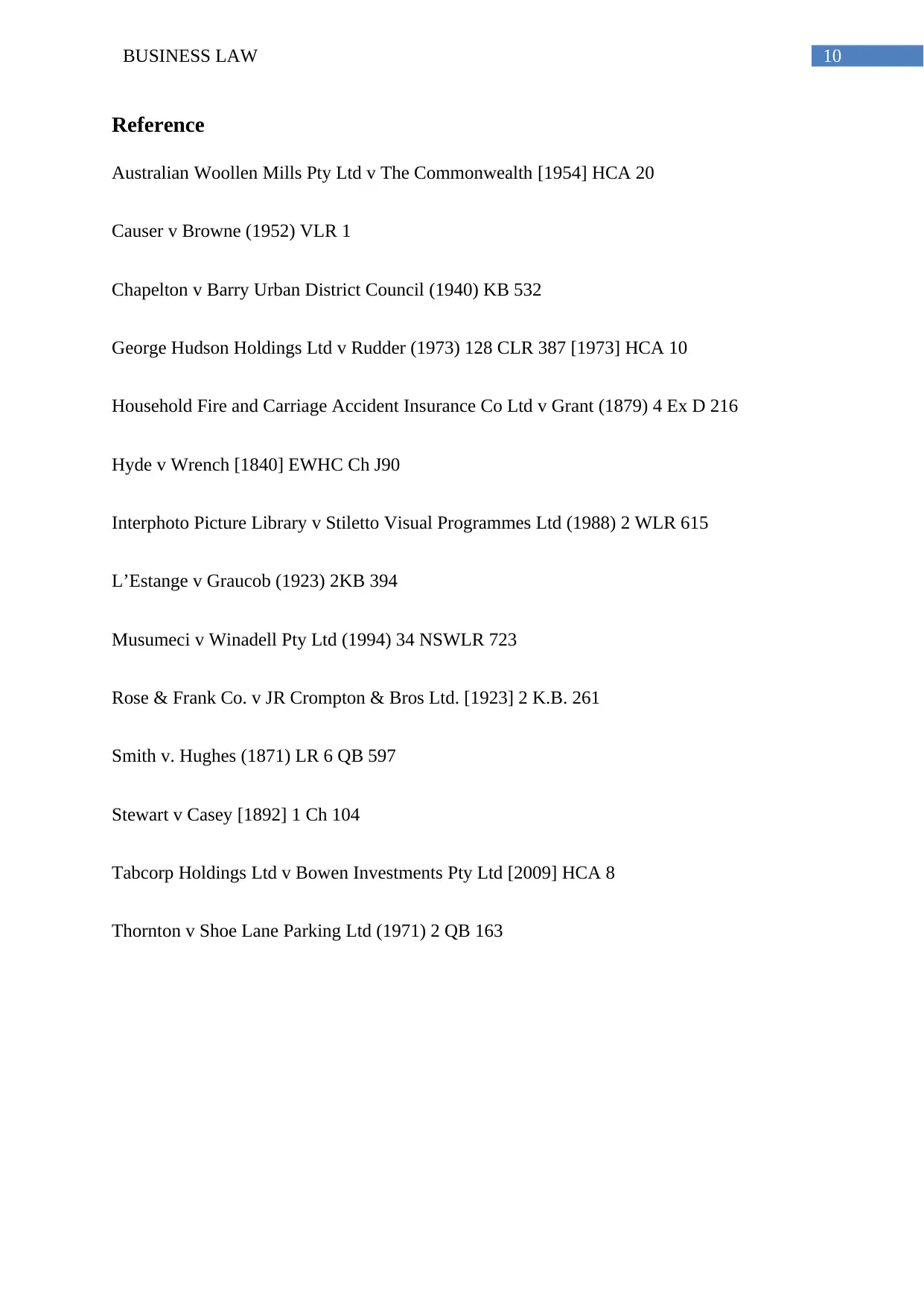
10BUSINESS LAW
Reference
Australian Woollen Mills Pty Ltd v The Commonwealth [1954] HCA 20
Causer v Browne (1952) VLR 1
Chapelton v Barry Urban District Council (1940) KB 532
George Hudson Holdings Ltd v Rudder (1973) 128 CLR 387 [1973] HCA 10
Household Fire and Carriage Accident Insurance Co Ltd v Grant (1879) 4 Ex D 216
Hyde v Wrench [1840] EWHC Ch J90
Interphoto Picture Library v Stiletto Visual Programmes Ltd (1988) 2 WLR 615
L’Estange v Graucob (1923) 2KB 394
Musumeci v Winadell Pty Ltd (1994) 34 NSWLR 723
Rose & Frank Co. v JR Crompton & Bros Ltd. [1923] 2 K.B. 261
Smith v. Hughes (1871) LR 6 QB 597
Stewart v Casey [1892] 1 Ch 104
Tabcorp Holdings Ltd v Bowen Investments Pty Ltd [2009] HCA 8
Thornton v Shoe Lane Parking Ltd (1971) 2 QB 163
Reference
Australian Woollen Mills Pty Ltd v The Commonwealth [1954] HCA 20
Causer v Browne (1952) VLR 1
Chapelton v Barry Urban District Council (1940) KB 532
George Hudson Holdings Ltd v Rudder (1973) 128 CLR 387 [1973] HCA 10
Household Fire and Carriage Accident Insurance Co Ltd v Grant (1879) 4 Ex D 216
Hyde v Wrench [1840] EWHC Ch J90
Interphoto Picture Library v Stiletto Visual Programmes Ltd (1988) 2 WLR 615
L’Estange v Graucob (1923) 2KB 394
Musumeci v Winadell Pty Ltd (1994) 34 NSWLR 723
Rose & Frank Co. v JR Crompton & Bros Ltd. [1923] 2 K.B. 261
Smith v. Hughes (1871) LR 6 QB 597
Stewart v Casey [1892] 1 Ch 104
Tabcorp Holdings Ltd v Bowen Investments Pty Ltd [2009] HCA 8
Thornton v Shoe Lane Parking Ltd (1971) 2 QB 163
1 out of 11
Related Documents
Your All-in-One AI-Powered Toolkit for Academic Success.
+13062052269
info@desklib.com
Available 24*7 on WhatsApp / Email
![[object Object]](/_next/static/media/star-bottom.7253800d.svg)
Unlock your academic potential
Copyright © 2020–2025 A2Z Services. All Rights Reserved. Developed and managed by ZUCOL.





